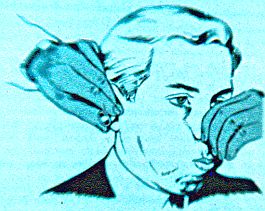 Maniobra que consiste en cerrar con los dedos los agujeros de la nariz impidiendo de esta forma que el aire pueda escapar por ellas, después de esto, se sopla por la nariz de tal forma que la presión aumenta en la nasofaringe abriéndose las trompas y en consecuencia, entra aire desde la nasofaringe al oído medio equilibrando su presión con la exterior. A la vez el explorador realiza una otoscopia para comprobar si hay un movimiento de abombamiento del tímpano. Fue descrita por Antonio María Valsalva (1666-1723).
Maniobra que consiste en cerrar con los dedos los agujeros de la nariz impidiendo de esta forma que el aire pueda escapar por ellas, después de esto, se sopla por la nariz de tal forma que la presión aumenta en la nasofaringe abriéndose las trompas y en consecuencia, entra aire desde la nasofaringe al oído medio equilibrando su presión con la exterior. A la vez el explorador realiza una otoscopia para comprobar si hay un movimiento de abombamiento del tímpano. Fue descrita por Antonio María Valsalva (1666-1723). <(A): Valsalva-Manöver, Valsalva-Test, Valsalva-Methode: Ein Valsalva-Manöver, das gegen eine geschlossene Glottis durchgeführt wird, führt zu einem drastischen Druckanstieg in der Brusthöhle, dem luftdichten Abschnitt des Rumpfes, der die Lungen und das Herz beherbergt. Bei normaler Ausatmung zieht sich das Zwerchfell zusammen und drückt nach oben und in die Brusthöhle. Dadurch erhöht sich der Druck in der Brusthöhle und drückt die Luft aus den Lungen. Wenn die Luft jedoch nicht entweichen kann, wie z.B. bei einem Valsalva-Manöver, wenn die Stimmritze geschlossen ist, baut sich der Druck in der Brusthöhle einfach weiter auf, bis sich das Zwerchfell entspannt oder die Luft entweichen kann. Dadurch wird die Menge des Blutflusses in die Brusthöhle verringert, insbesondere in den Venen, die zum rechten Vorhof des Herzens führen.
<(F): Manœuvre de Valsalva: il y a deux variantes. Après une inspiration profonde, on fait un effort d'expiration en contractant la glotte (en contractant les muscles abdominaux) ou en se bouchant la bouche et le nez (en gonflant le canal auditif «trompes d'Eustache»). La première variante est souvent utilisée durant un bref effort musculaire, la seconde, pour s'adapter à un changement de pression atmosphérique, par exemple, dans un avion, durant le décollage ou l'atterrissage. Nommée ainsi d'après l'anatomiste italien Antonio Maria Valsalva (1666-1723).
<(Ing): Valsalva maneuver, Valsalva's test, Valsalva's method: a Valsalva maneuver performed against a closed glottis results in a drastic increase in pressure in the thoracic cavity, the airtight section of the torso that houses the lungs and heart. In normal exhalation, the diaphragm contracts, pushing up and into the thoracic cavity. This increases pressure in the cavity and forces the air out of the lungs. However, when the air cannot escape, as when the glottis is closed in a Valsalva maneuver, pressure simply continues to build inside the thoracic cavity until the diaphragm relaxes or the air is allowed to escape. This reduces the amount of blood flow into the thoracic cavity, especially in the veins leading to the right atrium of the heart.
FUENTES DE INFORMACIÓN BIOMÉDICA:
- CISMeF. <(F)
- GOOGLE ACADEMICO. <(E)
- GOOGLE SCHOLAR. <(Ing)
- NCBI: Entrez. <(Ing)
- PubMed. <(Ing)
INFORMACIÓN PACIENTES:
- WIKIPEDIA. <(F)
TEXTOS:
- OCEANDIVI. <(E)
- OTOPATHIES DYSBARIQUES. <(F)
TÉRMINOS RELACIONADOS:
